Sunflowers (Helianthus annuus), commonly known as common sunflower or garden sunflower. You may find growing sunflowers provides a striking appearance, ecological benefits, and practical uses.
Belonging to the Asteraceae family, they are native to North America but have been cultivated globally for centuries. These sun-loving plants thrive in USDA Hardiness Zones 2–11 as annuals, completing their life cycle in a single growing season.
While perennial sunflower species exist, Helianthus annuus is strictly an annual (it’s right there in the name), although it readily self-seeds in suitable conditions, often reappearing the following year.
Most gardeners find growing sunflowers is easiest during the warm season, thriving in full sun with long summer days. Plant them in spring after the last frost when they can grow vigorously through summer.
They’ll reach maturity in late summer to early fall. Their adaptability to various climates and soil types makes them a staple in home gardens, farms, and large-scale agricultural production.
Why We Love Growing Sunflowers So Much

Gardeners and farmers cultivate sunflowers for multiple reasons. Their vibrant blooms make excellent ornamental additions to landscapes, while their seeds are harvested for food, bird feed, and oil production.
Sunflowers also serve as an essential component in pollinator-friendly gardens, attracting bees, butterflies, and other beneficial insects. Their deep taproots improve soil structure, and their towering stalks provide natural windbreaks or shade for companion plants.
Some varieties are even used in phytoremediation, helping remove toxins from the soil.
With their impressive height, bright yellow petals, and large seed-filled centers, sunflowers are an iconic symbol of summer. Whether you’re growing sunflowers for their beauty, wildlife benefits, or practical uses, they are a rewarding and versatile addition to any garden.
Sunflowers: Towering Giants of the Garden
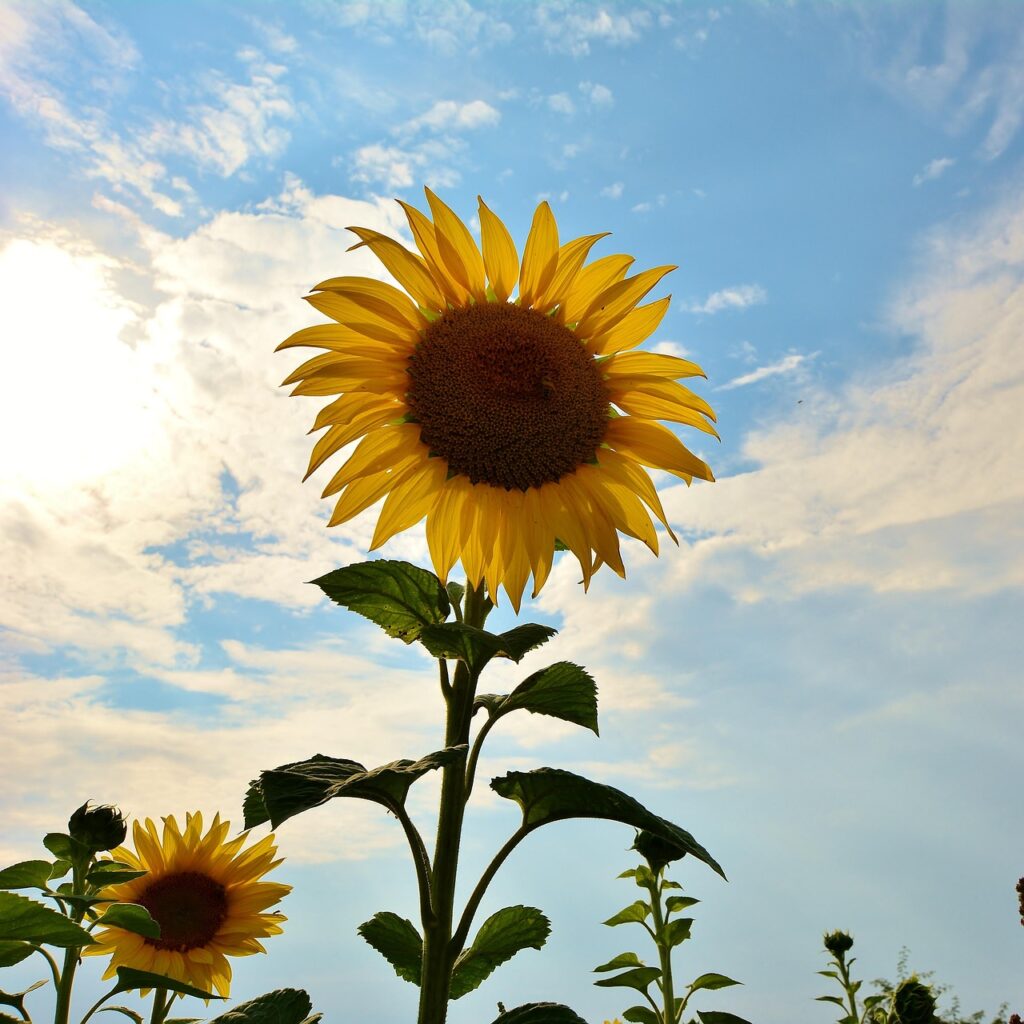
Sunflowers (Helianthus annuus) are best known for their large, daisy-like flower heads, which can range from a few inches to over a foot in diameter. The classic sunflower features bright yellow petals (ray florets) surrounding a dark brown or black center (disk florets), but modern cultivars come in shades of red, burgundy, orange, cream, and even bi-color combinations.
Sunflowers vary significantly in size, depending on the variety. Some dwarf types stay compact at around 1–2 feet tall, while giant cultivars, such as Mammoth Grey Stripe sunflowers, can reach towering heights of 12 feet or more.
The plant’s spread also varies, with branching varieties producing multiple flower heads and occupying a wider space, while single-stem varieties grow in a more upright, columnar fashion.
Sunflowers are commonly planted in:
- Garden borders and flower beds for a striking visual impact
- Wildlife and pollinator gardens to attract bees, butterflies, and birds
- Vegetable gardens as companion plants to provide shade and wind protection
- Along fences or property lines for natural privacy screens
- Field plantings and large-scale farms for commercial seed and oil production
Popular Sunflower Varieties
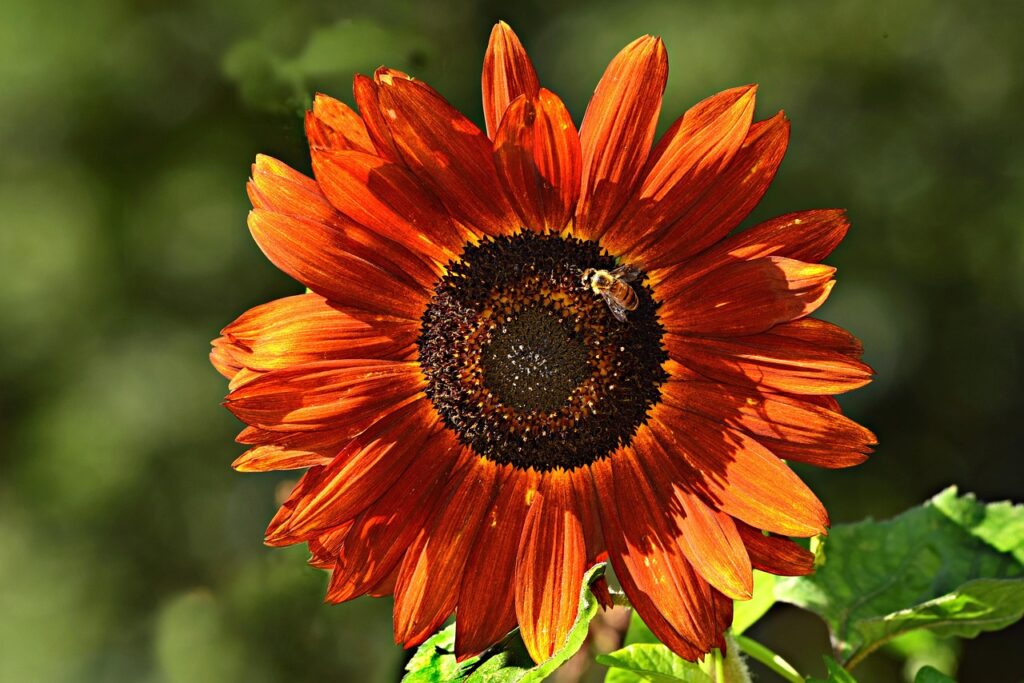
Sunflowers come in a wide range of sizes, colors, and growth habits, making them suitable for different garden spaces. Here are ten popular varieties:
Wild Sunflower (Helianthus annuus)
The native, wild-growing form with multiple small to medium-sized yellow flowers on branching stems; can reach 5–10 feet tall.
Mammoth Grey Stripe
A giant sunflower variety that grows 10–12 feet tall with massive flower heads up to 14 inches wide, producing large edible seeds.
Autumn Beauty

A branching variety with multiple blooms in warm shades of yellow, orange, bronze, and red; grows 5–7 feet tall.
Teddy Bear

A dwarf, bushy variety reaching only 2–3 feet tall, with fluffy, fully double golden-yellow blooms.
Sunrich Gold
A pollen-free, single-stem variety with uniform golden-yellow flowers about 4–6 inches in diameter; ideal for cut flowers.
Lemon Queen

A branching variety with pale yellow petals and a dark brown center; grows 5–7 feet tall and is favored by pollinators.
Velvet Queen
A deep red to burgundy sunflower with a dark center; reaches 5–6 feet tall with multiple blooms per plant.
Italian White
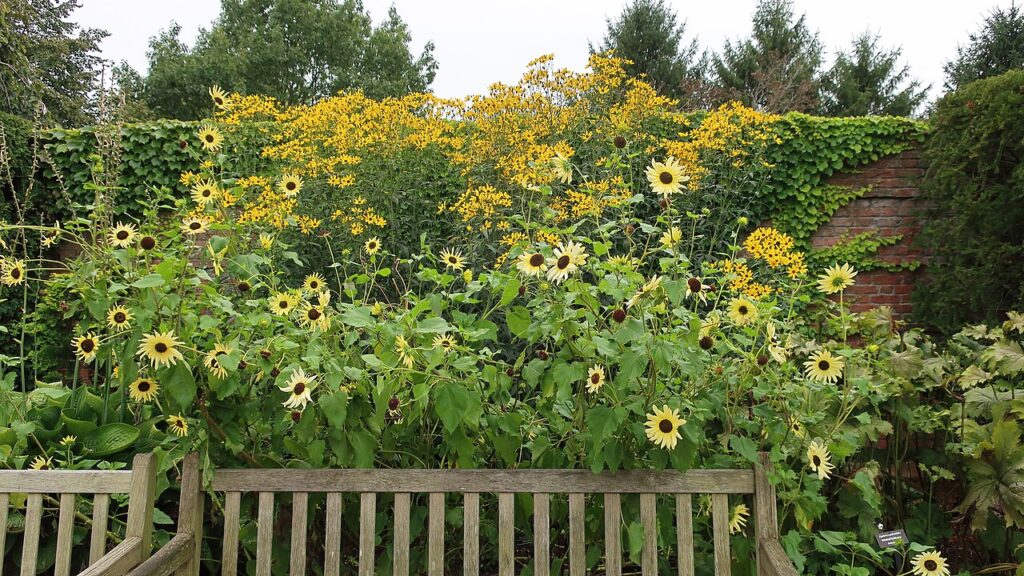
A unique heirloom variety producing creamy white flowers with chocolate-colored centers; grows 4–5 feet tall.
Firecracker
A dwarf, multi-branching variety with bi-colored red and yellow blooms; grows about 2–3 feet tall, making it suitable for containers.
Russian Giant
A massive sunflower similar to Mammoth Grey Stripe, reaching 10–14 feet tall with huge seed-filled flower heads.
Whether you prefer towering sunflowers that dominate the landscape or compact varieties for smaller spaces, there is a sunflower to suit every garden.
When to Start Growing Sunflower Seeds

Sunflowers are best started from seed directly in the garden, as they have long taproots that do not transplant well. However, in colder climates with short growing seasons, starting seeds indoors can give them a head start.
Sunflower seeds should be planted after the last frost date when soil temperatures reach at least 50–60°F (10–16°C) for optimal germination.
Zones 3-5 (Cool Climates)
- Starting Indoors: If desired, sow sunflower seeds indoors in biodegradable pots 2–4 weeks before the last expected frost. Transplant with care to avoid disturbing the taproot.
- Direct Sowing: Sow seeds directly outdoors in mid to late spring, once the soil warms to at least 50°F (10°C), typically from late May to early June.
Zones 6-8 (Mild Climates)
- Starting Indoors: Can be started indoors 2–3 weeks before the last frost in early spring.
- Direct Sowing: Plant seeds outdoors from mid-spring through early summer, once the danger of frost has passed. In long growing seasons, successive plantings every 2–3 weeks can extend the bloom period.
Zones 9-12 (Warm Climates)
- Starting Indoors: Generally not necessary, as sunflowers grow quickly in warm soil. However, seeds can be started indoors in late winter if an early bloom is desired.
- Direct Sowing: Sow seeds outdoors from late winter through early summer. In frost-free regions, sunflowers can be grown nearly year-round, though they perform best when planted in cooler months before peak summer heat.
Sunflower Seed Preparation
Sunflower seeds generally germinate easily and do not require special pre-treatment. However, in some cases, preparation can help improve germination rates.
While not necessary, soaking sunflower seeds can speed up germination. To do this:
- Place seeds in a bowl of lukewarm water.
- Soak for 8–12 hours, but no longer than 24 hours to prevent rot.
- Drain and plant immediately in prepared soil.
Soaking is especially useful in dry climates or when planting in late summer for a fall harvest. However, sunflower seeds will still germinate reliably without this step.
Preparing the Garden Bed for Sunflowers
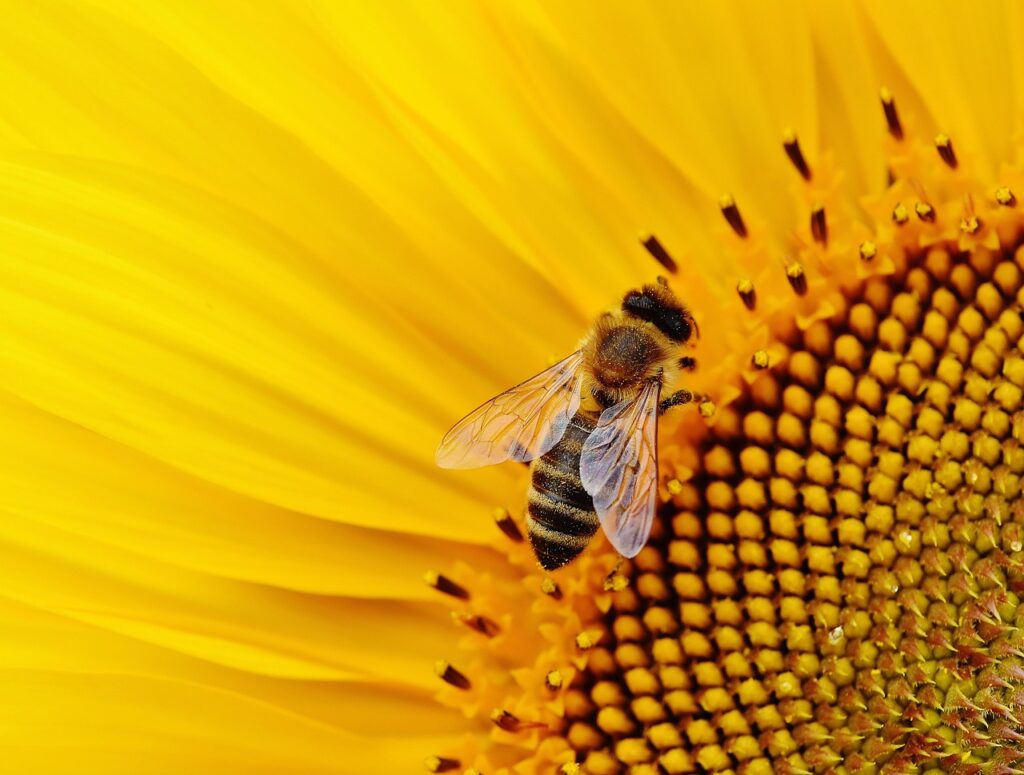
Properly preparing the garden bed ensures strong, healthy sunflower growth. Sunflowers thrive in well-draining, nutrient-rich soil with plenty of sunlight. Since they develop deep taproots, the soil should be loosened deeply to support their growth. Follow these step-by-step instructions to create the ideal planting environment.
1. Choosing a Location
Select a site that provides ample space for growing sunflowers without crowding other plants. Consider the following factors:
- Choose a wind-sheltered location if growing tall varieties, as strong winds can topple them.
- Avoid planting near small, sun-loving plants that may get shaded out.
- Rotate planting locations each year to prevent soil depletion and pest buildup.
2. Light Requirements
Sunflowers require full sun, meaning at least 6–8 hours of direct sunlight per day. More sun exposure leads to stronger, taller plants and larger blooms. Insufficient sunlight may result in weak stems and smaller flower heads.
3. Moisture
- Sunflowers need moderate but consistent moisture, especially during early growth.
- Avoid waterlogged soil, as standing water can cause root rot. Ensure the area has good drainage.
- In dry climates, consider using mulch to help retain soil moisture.
4. Soil Type, Organic Matter, and pH
Sunflowers prefer loamy, well-draining soil that is rich in organic matter. The ideal soil conditions are:
- Soil Type: Loose, well-aerated soil that allows deep root penetration.
- Organic Matter: Amend soil with compost or well-rotted manure to boost fertility.
- pH Range: Slightly acidic to neutral soil (pH 6.0–7.5) is best. If soil is too acidic, add lime; if too alkaline, incorporate organic materials like compost.
Before planting, loosen the soil to at least 12–18 inches deep to accommodate sunflower taproots. Remove weeds and debris to minimize competition.
5. Any Need for Trellising or Support?
- Tall varieties (8 feet and above): May require staking or support, especially in windy areas. Drive a sturdy stake 6 inches away from the plant and loosely tie the stem as it grows.
- Branching sunflowers: Generally do not require support, as their multiple stems provide stability.
- Dwarf varieties (under 3 feet): Do not need support and can be grown in containers or garden beds without issue.
By preparing a well-drained, nutrient-rich garden bed in a sunny location, you create the best conditions for growing sunflowers that produce vibrant, healthy blooms.
Direct Sowing Sunflower Seeds
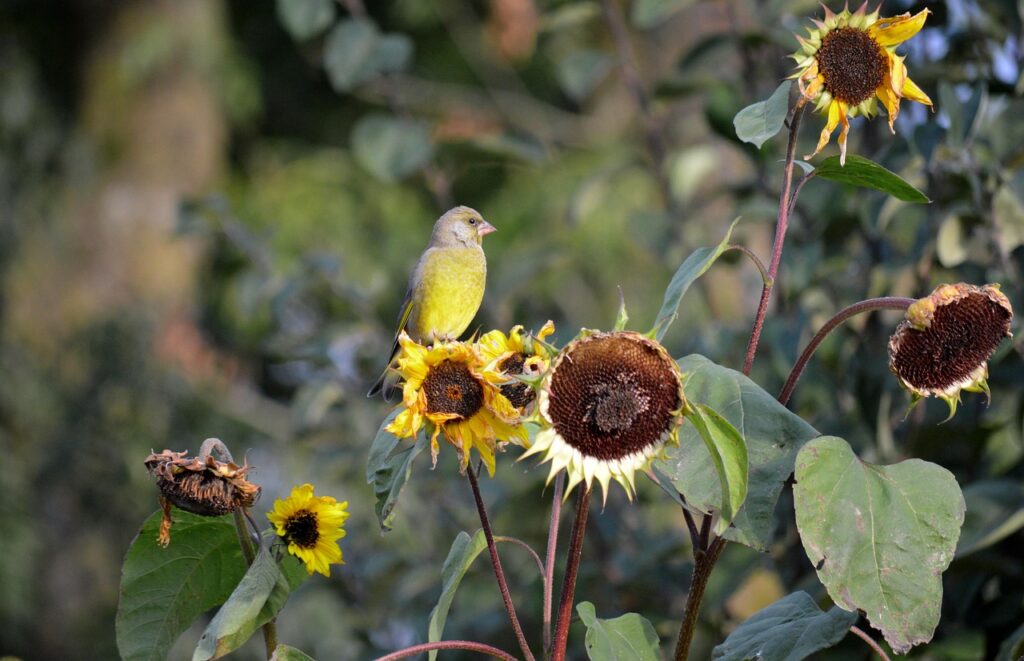
Growing sunflowers sown directly into the garden is best, as they do not transplant well due to their deep taproots. Direct sowing ensures strong root development and minimizes transplant shock. Follow these step-by-step instructions to successfully plant sunflower seeds outdoors.
1. Depth to Plant
- Sow sunflower seeds ½ to 1 inch deep in loose, well-prepared soil.
- Cover lightly with soil and press down gently to ensure good seed-to-soil contact.
- Space seeds 6–12 inches apart for small and branching varieties and 18–24 inches apart for larger varieties to prevent overcrowding.
2. Moisture Requirement for Seeds
- Keep soil consistently moist but not waterlogged during germination.
- Water gently after planting to settle the soil.
- Continue to water lightly but frequently until seedlings establish, ensuring the top inch of soil remains moist.
3. Optimal Temperature for Germination
- Sunflowers germinate best when soil temperatures are between 60–85°F (16–29°C).
- Planting in soil cooler than 50°F (10°C) may result in slow or poor germination.
- Warmer temperatures accelerate germination, with seeds sprouting more quickly in soil above 70°F (21°C).
4. Light Requirements for Germination
- Sunflower seeds do not require light to germinate; they germinate best when covered with soil.
- However, once seedlings emerge, they need full sun (at least 6–8 hours per day) to develop strong stems.
5. Time to Germination
- Sunflower seeds typically germinate within 7–10 days under optimal conditions.
- Warmer temperatures and consistent moisture can speed up germination, while cooler soil may delay it.
Growing Sunflower Seed Starts Indoors
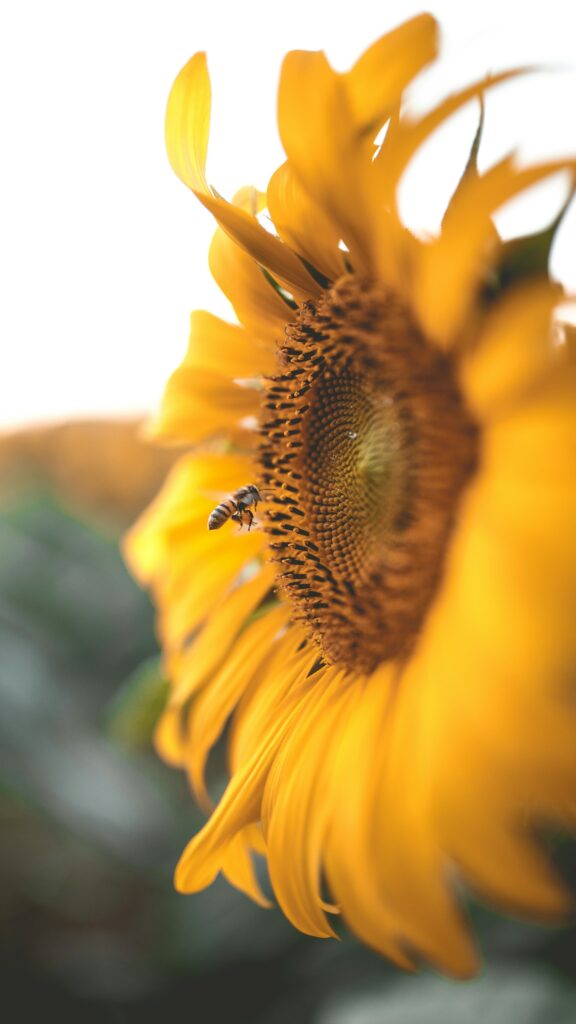
While sunflowers grow best when directly sown in the garden, they can be started indoors if necessary, particularly in regions with short growing seasons. However, because sunflowers develop deep taproots, they do not transplant well if left too long in containers.
To minimize root disturbance, use deep containers and transplant seedlings promptly once they develop strong roots.
How to Start Indoors
1. Choosing or Making a Seed Starting Mix
Growing sunflowers indoors requires a lightweight, well-draining seed starting mix that retains moisture without becoming compacted. The ideal mix includes:
- 1 part peat moss or coconut coir (retains moisture while keeping the mix airy)
- 1 part perlite or vermiculite (improves drainage and aeration)
- 1 part compost or worm castings (provides nutrients for early growth)
Avoid using garden soil, which is too dense and may harbor pathogens.
2. Choosing Containers for Starting Sunflower Seeds
Since sunflowers have deep taproots, choose deep containers to allow for healthy root development. Ideal container options include:
- Biodegradable pots (peat pots, paper pots, or soil blocks) – These minimize transplant shock as they can be planted directly into the garden.
- 4-inch deep pots – Provide enough room for root growth if transplanting early.
- Avoid shallow seed trays, as sunflower roots outgrow them quickly.
3. Depth to Plant
- Sow seeds ½ to 1 inch deep in the seed starting mix.
- Cover lightly with soil and press down gently to ensure good seed-to-soil contact.
4. Moisture Requirement for Seeds
- Keep the soil evenly moist but not waterlogged.
- Water gently after planting and mist the soil surface if it begins to dry out.
- A humidity dome or plastic wrap can help retain moisture until germination.
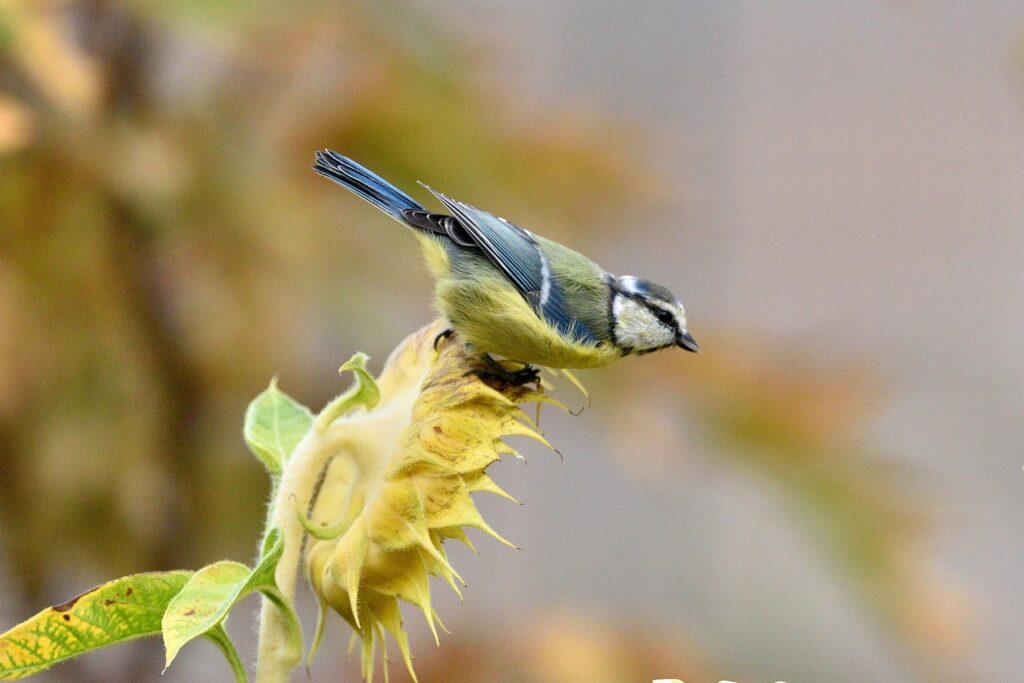
5. Optimal Temperature for Germination
- Sunflower seeds germinate best at 60–85°F (16–29°C).
- Use a heat mat if necessary to maintain soil warmth, especially in cooler indoor conditions.
6. Light Requirements for Germination
- Sunflower seeds do not require light to germinate, but once they sprout, they need strong, direct light to prevent legginess.
- Provide 14–16 hours of bright light per day using a grow light or a sunny south-facing window.
- Keep grow lights 2–3 inches above the seedlings and adjust as growing sunflowers get taller to maintain proper distance.
7. Time to Germination
- Sunflower seeds typically germinate within 7–10 days under ideal conditions.
Once seedlings develop two sets of true leaves, they should be hardened off and transplanted into the garden promptly to prevent root binding.
When to Plant Out Sunflower Plants
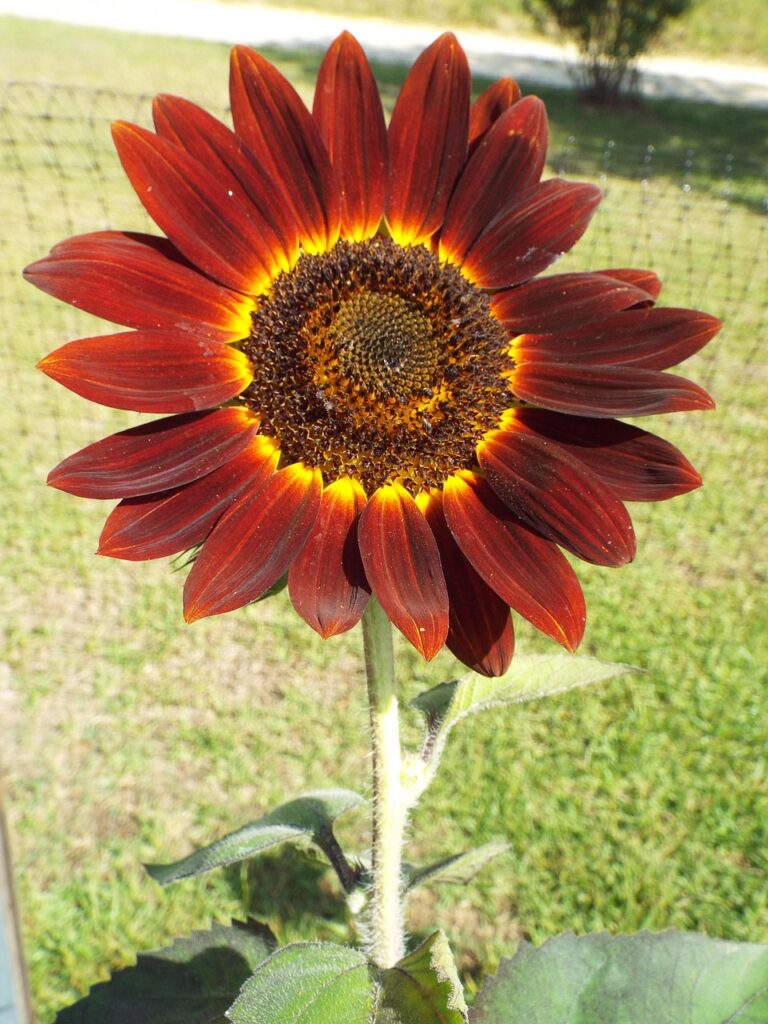
Sunflower seedlings should be transplanted into the garden once they are strong enough to handle outdoor conditions and the risk of frost has passed. Proper timing ensures healthy root establishment for growing sunflowers and prevents transplant shock.
Your sunflower seedlings are ready for transplanting when:
- They are 3–4 weeks old and have developed two to four sets of true leaves.
- The daytime temperatures are consistently above 55°F (13°C) and nighttime temperatures remain above 50°F (10°C).
- The roots are well-developed but not root-bound (check the bottom of the container for visible roots).
- The last expected frost date has passed in your region.
Before transplanting, seedlings must be hardened off to adapt them to outdoor conditions.
Hardening Off Growing Sunflowers Seedlings
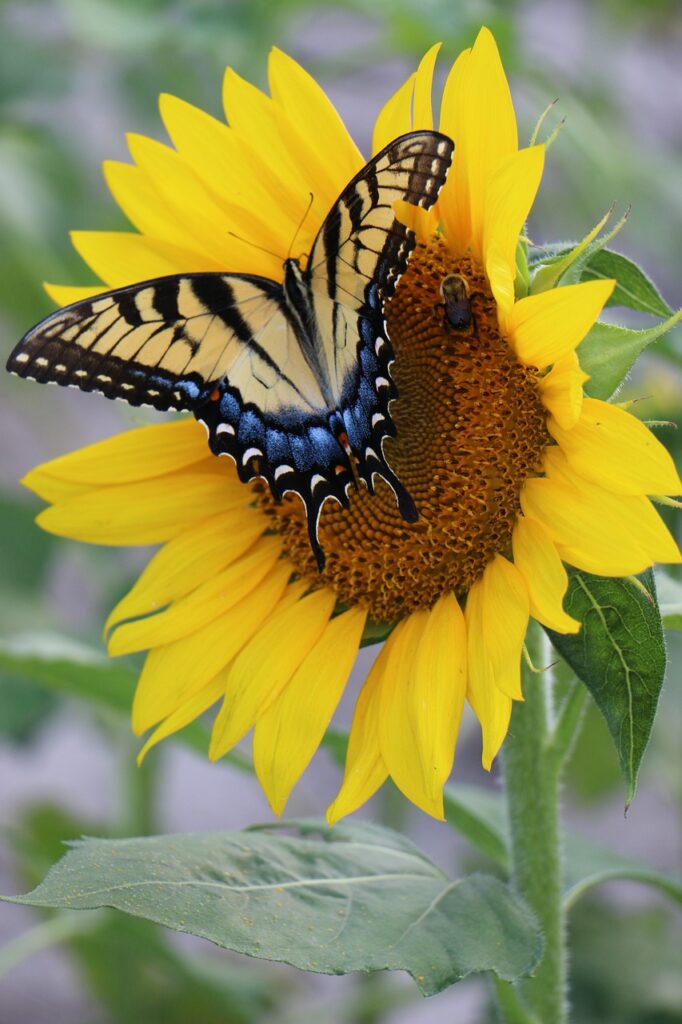
Hardening off is the process of gradually introducing indoor-grown seedlings to outdoor conditions to prevent transplant shock. This process should be done over 7–10 days before planting them in the garden.
Step-by-Step Hardening Off Guide
- Choose a Sheltered Location
- Place seedlings in a shaded, wind-protected area outdoors for 1–2 hours on the first day.
- Avoid direct sunlight and strong winds, which can stress young plants.
- Increase Exposure Gradually
- Each day, gradually increase the amount of time the seedlings spend outside by 1–2 hours.
- Begin introducing them to morning sunlight after the first few days.
- Introduce More Sunlight and Wind
- By day 4 or 5, place seedlings in an area with direct sunlight for a few hours.
- Allow them to experience gentle breezes to strengthen their stems.
- Reduce Watering Slightly
- Let the top layer of soil dry out slightly between waterings to help toughen the plants.
- Avoid letting the plants wilt completely.
- Leave Them Outside Overnight (If Temperatures Allow)
- By day 7, if nighttime temperatures remain above 50°F (10°C), leave the seedlings outside overnight.
- If cold temperatures or strong winds are expected, continue bringing them indoors at night.
- Transplant Into the Garden
- Once seedlings have spent at least two full days and nights outside, they are ready for transplanting.
- Choose a calm, overcast day or plant in the late afternoon to reduce transplant stress.
Planting Out Sunflowers
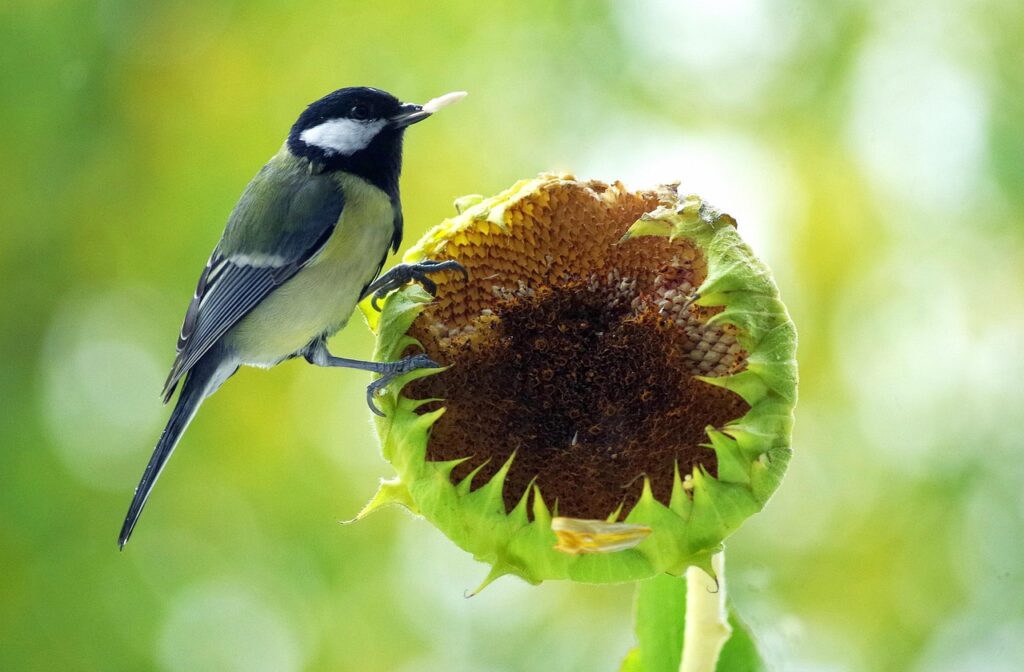
Once your sunflower seedlings have been hardened off, they are ready to be planted in the garden. Proper planting ensures healthy root establishment and strong stem development. Growing sunflowers do best in full sun with well-draining soil and should be planted in an area where they will receive at least 6–8 hours of direct sunlight per day.
Step-by-Step Guide to Planting Sunflowers
1. How Deep to Plant
- Dig a hole that is the same depth as the root ball of the seedling and slightly wider to allow room for root expansion.
- Sunflowers have deep taproots, so ensure the hole is at least 4–6 inches deep for young transplants.
- Place the seedling in the hole so that the top of the root ball is level with the soil surface.
2. Proper Spacing
- Tall varieties (over 5 feet): Space plants 18–24 inches apart to allow for strong stem development.
- Medium-sized varieties (3–5 feet): Space 12–18 inches apart.
- Dwarf or compact varieties (under 3 feet): Space 6–12 inches apart.
- If planting in rows, leave at least 24–36 inches between rows to accommodate growth.
3. Mulching
- Apply a 1–2 inch layer of organic mulch (such as straw, shredded leaves, or compost) around the base of each plant.
- Mulch helps retain moisture, suppress weeds, and regulate soil temperature.
- Keep mulch a few inches away from the stem to prevent rot.
4. Watering Instructions After Planting
- Water seedlings immediately after transplanting to help settle the soil and eliminate air pockets.
- Keep the soil evenly moist but not soggy during the first 1–2 weeks as the roots establish.
- After establishment, reduce watering to once or twice per week, providing 1–1.5 inches of water per week.
- Deep, infrequent watering encourages strong root growth and prevents weak, shallow roots.
With proper planting and care, your sunflowers will establish quickly and thrive, producing strong stems, lush foliage, and vibrant blooms throughout the growing season.
Sunflower Care

Sunflowers are relatively low-maintenance plants, but providing them with the right care can help them reach their full potential. Proper watering, feeding, weeding, and pest control are key components for ensuring strong, healthy plants and vibrant blooms.
1. Watering
Sunflowers have deep taproots that make them relatively drought-tolerant once established, but they still need regular watering, especially in the early stages of growth.
- Young plants: Water thoroughly after planting and for the first 2–3 weeks until the roots become established. Keep the soil moist, but avoid waterlogging.
- Established plants: Water deeply once or twice a week, providing around 1–1.5 inches of water per week, depending on the weather.
- Water at the base of the plant, avoiding wetting the leaves to reduce the risk of fungal diseases.
- If growing in containers, ensure that they have good drainage to prevent water from accumulating around the roots.
2. Feeding
Sunflowers are relatively heavy feeders, particularly when growing large flowers, so providing them with the proper nutrition can support their growth.
- Fertilize at planting: Add a balanced slow-release fertilizer (such as 10-10-10) to the soil before planting to give the plants an initial nutrient boost.
- Mid-season feeding: Once your sunflowers are around 12–18 inches tall, side-dress with a balanced fertilizer or one high in phosphorus and potassium to support flower development.
- Avoid excessive use of high-nitrogen fertilizers, which can lead to excessive foliage growth at the expense of flowers.
3. Weeding
Weeding is essential for sunflowers, as they can struggle for nutrients, water, and light if weeds are left to compete.
- Mulch: Applying a 1–2 inch layer of organic mulch around the base of sunflowers helps suppress weed growth and retains moisture.
- Hand weeding: Remove weeds around the sunflower plants by hand, particularly in the early stages of growth when sunflowers are young and less able to compete.
- Be cautious when weeding close to the plants, as sunflower roots are shallow, and disturbing them can cause damage.
4. Pest Control
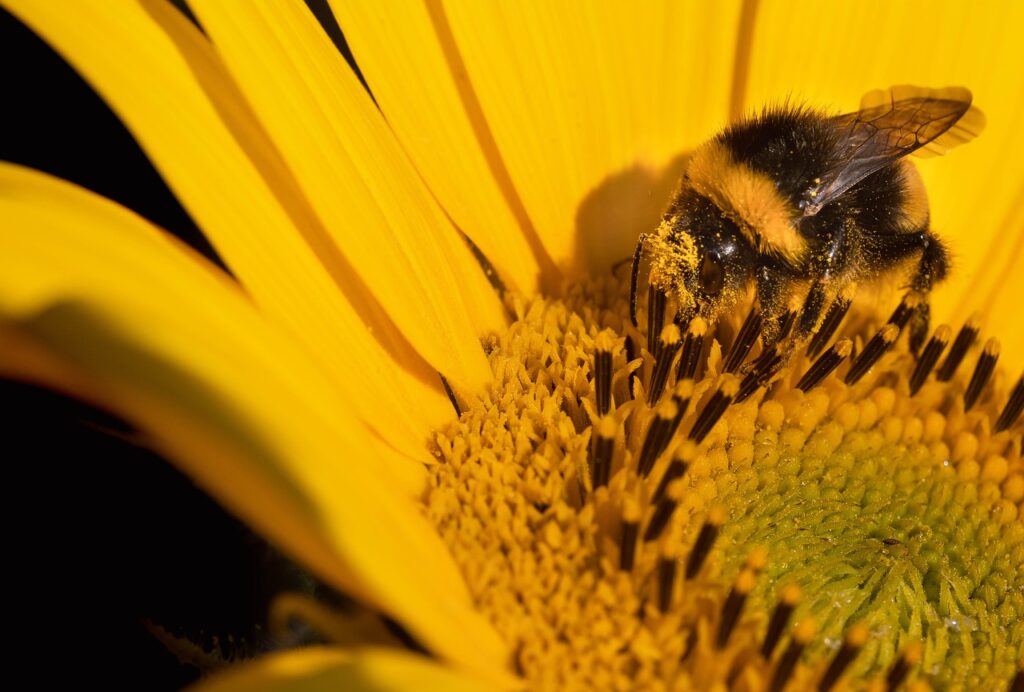
Sunflowers are generally pest-resistant, but they can be affected by a few common garden pests. Monitoring your plants and responding quickly can prevent pest problems from becoming serious.
- Aphids: These tiny insects can cause leaf curling and stunting. Use water spray or a soapy solution (1 tablespoon of dish soap per gallon of water) to dislodge aphids. In severe cases, use insecticidal soap or neem oil.
- Sunflower beetles: These pests can chew on sunflower leaves and flowers. Handpick them off the plants or use a biological insecticide like Bacillus thuringiensis (Bt) if the infestation is severe.
- Slugs and snails: Use diatomaceous earth or iron phosphate-based slug bait to deter these pests.
- Birds: Birds are often attracted to sunflower seeds. To protect your sunflowers from being eaten before they ripen, use netting or a bird scare tape to keep them away.
Some home gardeners say that growing sunflowers can help deter pests in the rest of their garden. This is because they will distract insects, birds, and other wildlife from feasting on other crops.
So, consider the benefit of using your growing sunflowers as a trap crop, instead.
Tips and Tricks for Growing Sunflowers
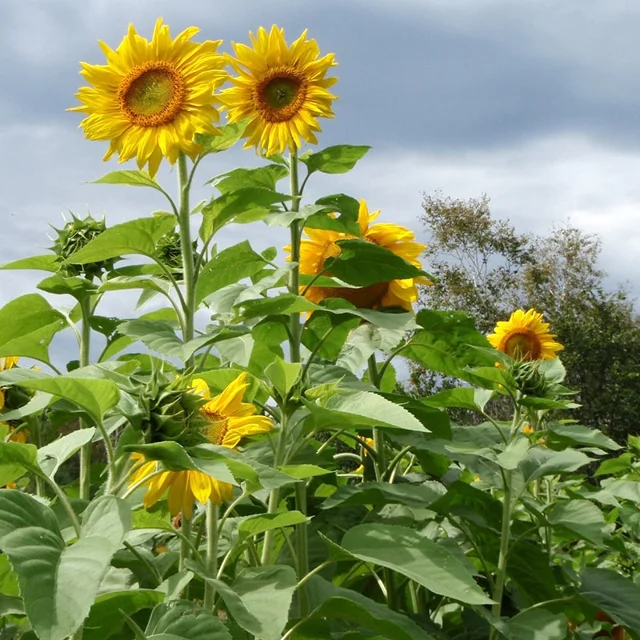
Sunflowers are relatively easy to grow, but there are a few tips and tricks that can help you achieve better growth and stronger blooms. While they are sturdy plants, paying attention to some specific care practices can lead to healthier plants and more vibrant flowers.
If you are growing smaller, branching sunflowers, like wild sunflowers, you can pinch back the top growth to encourage more lateral branching and multiple blooms. This is ideal if you want a bouquet of smaller flowers rather than one large flower per stem.
Tall sunflowers (6 feet or more) often benefit from staking or supports to prevent wind damage or leaning. Use bamboo stakes or sturdy wooden posts placed next to the plant and tie the sunflower to the support with soft plant ties or garden twine. Be sure to stake the plant early in its growth to avoid damaging its roots or main stem later.
Shorter varieties (under 3 feet) generally do not need staking, but taller varieties or those with large heads may require it to keep them upright, especially during storms or strong winds.
For extra protection, you can space taller sunflowers in a tight group to help them support each other, reducing the need for individual staking.
Sunflowers pair well with squash, beans, and corn. Known as the “Three Sisters” in Native American agriculture, these plants help each other thrive. Sunflowers provide vertical support for beans to climb, while the beans add nitrogen to the soil, and squash provides ground cover to retain moisture and suppress weeds.
Harvesting Sunflowers for Cut Flowers
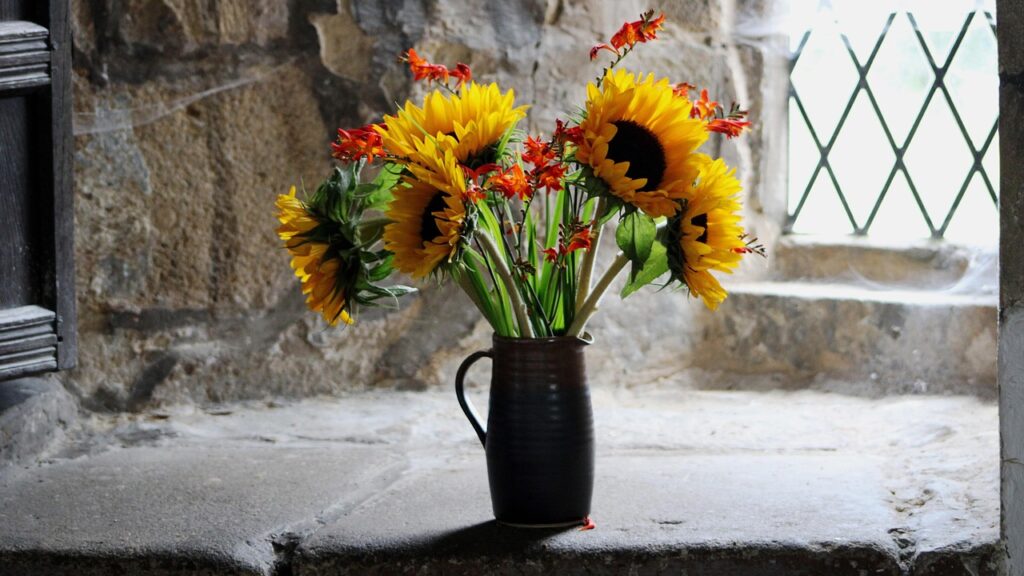
Sunflowers are exceptionally popular as cut flowers due to their bright, bold colors and large, dramatic blooms. They are ideal for bouquets and floral arrangements, making them a staple for gardeners looking to add a touch of sunshine to their home.
Cut sunflowers when the blooms are fully open but before the petals begin to fade. This ensures the flowers will last longer in a vase and maintain their vibrant appearance.
For the longest-lasting cut sunflowers, harvest the flowers early in the morning, when they are fresh and hydrated, to ensure the stems are firm and the blooms at their best.
The vase life of sunflowers is typically about 7–10 days, depending on how they are handled and the conditions they are kept in. The flower heads may droop as they age, but with proper care, they can last quite a while, especially if you follow correct cutting and water maintenance procedures.
Cutting and Prolonging Vase Life
- Cut the stem at a 45-degree angle to allow better water uptake.
- Use sharp shears or a knife to avoid crushing the stem.
- Harvest flowers early in the morning when they are fully hydrated.
- Remove any leaves that will be submerged in water to prevent decay.
- Place flowers in water immediately after cutting to keep them fresh.
- Change the water every 2 days to extend the vase life and prevent bacterial growth.
- Keep them in a cool, dark place when not in direct sunlight to prevent wilting.
Following these simple steps can ensure that your sunflowers remain stunning for as long as possible, brightening up any space with their sunny disposition.
How Long Do Sunflowers Bloom?
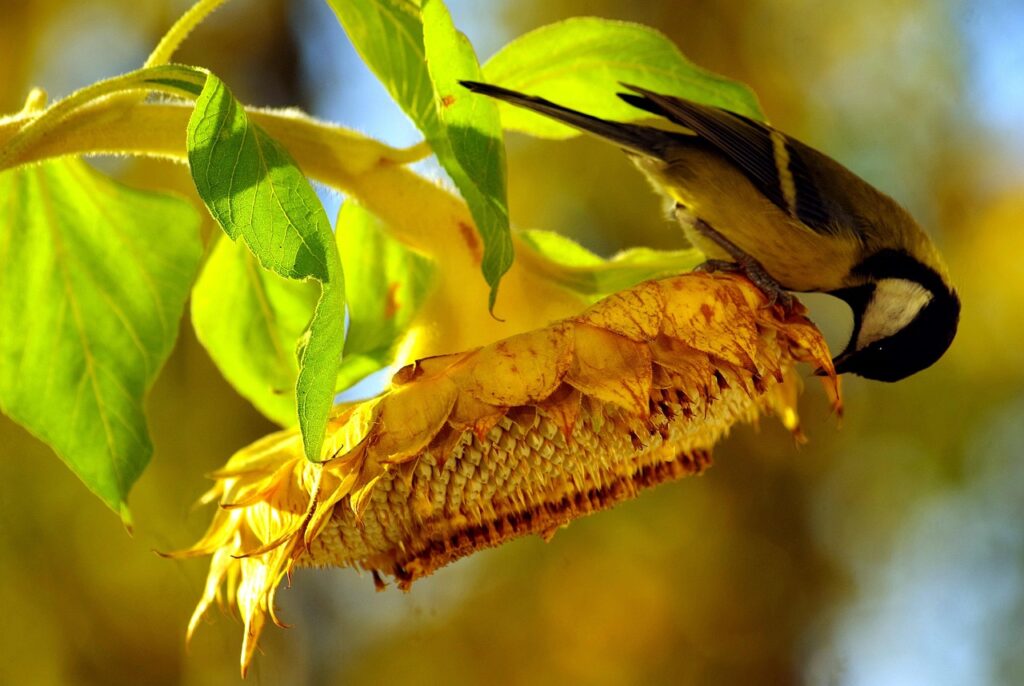
Sunflowers are typically summer bloomers, with their flowering period lasting for several weeks during the height of the growing season. Depending on the variety and growing conditions, most sunflowers will bloom for about 3–6 weeks, typically starting in mid to late summer and extending into early autumn.
Once the sunflowers finish blooming, the flowers start to fade, and the seeds begin to ripen. After flowering, the sunflower heads will gradually droop, and the petals will dry out, leaving behind the seeds. If you leave the seeds on the plant, they will naturally attract wildlife and can reseed themselves in the garden.
In winter, sunflowers will die back, and the stems will dry out. However, they still serve an important purpose in the garden during the colder months. Birds, especially finches and chickadees, love the seeds, and they often linger around dried sunflower heads to feast on the nutrient-rich seeds.
The tall, sturdy sunflower stems also provide habitat for insects and other wildlife, offering shelter during winter. If you choose to leave the sunflowers standing in your garden, they can serve as a valuable food source and wildlife habitat throughout the colder months.
Benefiting Species from Sunflowers in Winter
- Birds (e.g., finches, chickadees, woodpeckers) who feed on sunflower seeds.
- Squirrels and other small mammals that may also harvest fallen seeds.
- Insects (e.g., beetles and caterpillars) that may overwinter on the sunflower stems.
- Pollinators like bees, which might find shelter among the dry plant material.
By leaving sunflowers in your garden over the winter, you can help support local wildlife while also benefiting from the reseeding process for future growth.
Collecting Sunflower Seeds
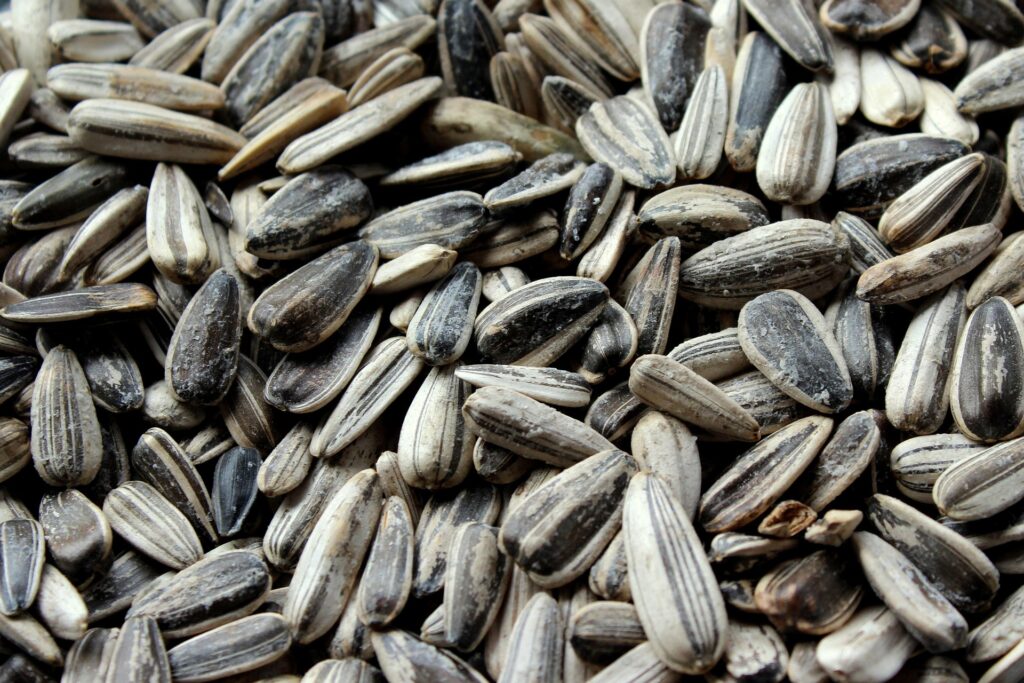
Harvesting sunflower seeds is a straightforward process, whether you’re collecting them for replanting or for eating. Sunflowers typically produce abundant seeds, making them an excellent choice for gardeners who want to save their harvest for the following season or enjoy them as a snack. Here’s how to properly collect and store sunflower seeds.
How to Harvest and Collect Sunflower Seeds to Replant
- Wait for the seeds to mature: Allow the sunflower heads to fully mature before harvesting. The back of the sunflower head should turn yellow or brown, and the seeds should appear plump and well-formed. The petals will begin to dry out and fall off naturally.
- Cut the flower head: Use sharp shears or a garden knife to cut the flower head from the plant when it’s fully mature. Leave about 6–8 inches of stem attached to the head for easier handling.
- Dry the flower head: Hang the sunflower head in a dry, well-ventilated area away from direct sunlight to allow the seeds to dry completely. This process usually takes 1-2 weeks.
- Remove the seeds: Once dried, gently rub the sunflower head to loosen the seeds. You can use your hands or a small brush to extract the seeds. Some sunflowers will have a mesh or netting that holds seeds in place—simply pull apart the netting to release them.
- Store seeds: After removing the seeds, clean them by gently brushing off any remaining debris. Store the seeds in a cool, dry location in a sealed container or envelope until you’re ready to plant them next season.
How to Harvest and Collect Sunflower Seeds for Eating

- Choose a variety for consumption: If you intend to harvest sunflower seeds for eating, choose varieties known for their edible seeds, such as the Mammoth Grey Stripe or Black Oil sunflowers, which have larger seeds.
- Allow seeds to fully mature: Just like for planting, allow the sunflower heads to mature completely before harvesting. The seeds should be firm, and the back of the flower head will turn brown or yellow.
- Cut the flower heads: Using sharp garden shears or a knife, cut the flower heads from the plant, leaving several inches of stem attached.
- Dry the sunflower heads: Hang the sunflower heads upside down in a dry, cool area with good airflow. Leave them for about 1-2 weeks to fully dry and ensure the seeds come loose easily.
- Extract the seeds: Once dried, gently rub the heads to loosen the seeds. Alternatively, you can scrape them off with a brush or a small rake.
How to Prepare Sunflower Seeds for Eating
- Remove the seeds: After harvesting the seeds, separate them from the flower head and clean them thoroughly to remove any debris.
- Dry the seeds: Lay the seeds out on a tray and allow them to air dry for a few days, ensuring they are completely dry before storing. This prevents mold from forming.
- Roasting: If you want to roast the sunflower seeds:
- Preheat your oven to 350°F (175°C).
- Spread the seeds on a baking sheet in a single layer.
- Roast for about 10-15 minutes, stirring occasionally, until golden and crisp.
- Optionally, toss the seeds with a little olive oil and salt for added flavor before roasting.
- Salted or flavored seeds: After roasting, you can sprinkle salt, garlic powder, or other seasonings on the seeds to enhance their flavor.
How to Store Sunflower Seeds for Eating
- Airtight container: Store the dried, roasted seeds in an airtight container or resealable bag to maintain freshness.
- Cool, dry place: Keep the container in a cool, dry location away from heat or humidity, such as a pantry or cupboard.
- Shelf life: Properly stored sunflower seeds can last for several months if kept in ideal conditions.
With these steps, you can enjoy the fruits of your labor by replanting the seeds for next season or savoring them as a delicious, nutritious snack.
Growing Sunflowers for a Personal Paradise!
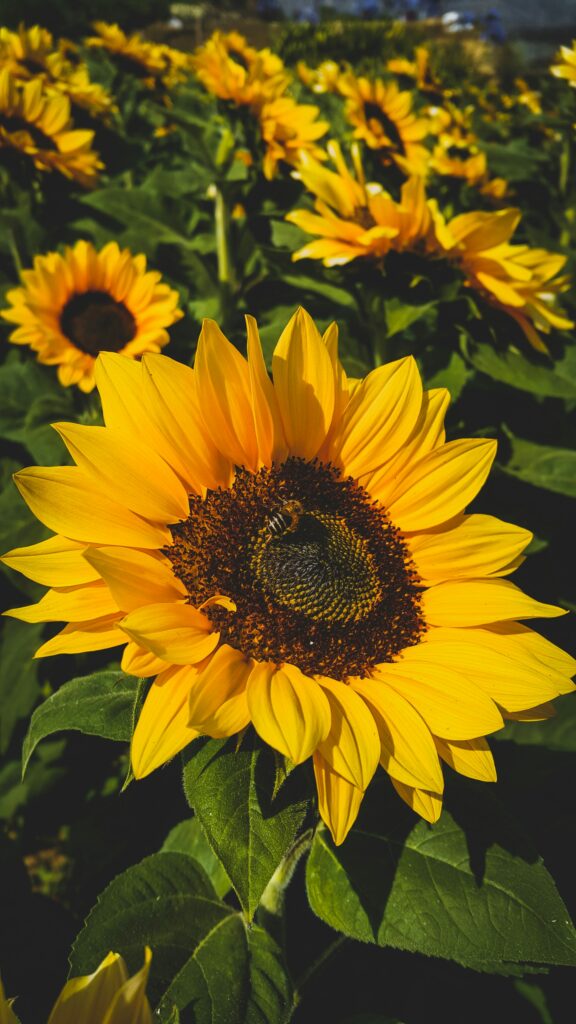
Sunflowers are not only stunning but also incredibly rewarding to grow. Whether you’re planting them for their bold, sunny blooms, saving seeds for future planting, or enjoying them as a healthy snack, these versatile plants are a fantastic addition to any garden. From attracting pollinators to providing food for birds in winter, sunflowers serve multiple roles throughout the year.
Now that you know how to grow and care for sunflowers from seed, it’s time to get started! Whether you’re a seasoned gardener or a first-time grower, sunflowers are an easy and fun plant to add to your garden.
So, grab some seeds, choose your perfect planting spot, and start sowing your sunflowers today. You’ll be rewarded with vibrant flowers that brighten your garden and provide benefits for wildlife, all season long. Happy gardening!
